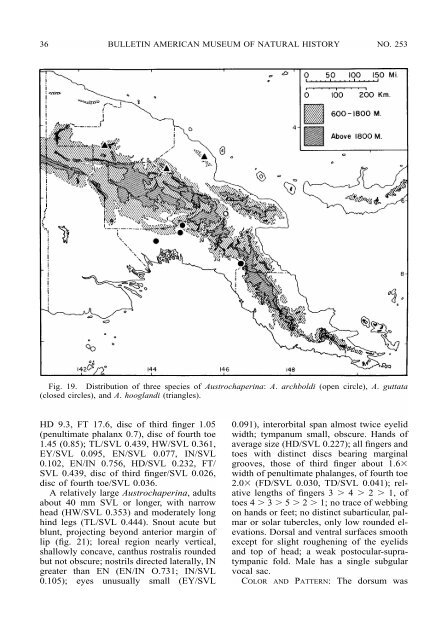SPHENOPHRYNE - American Museum of Natural History
SPHENOPHRYNE - American Museum of Natural History
SPHENOPHRYNE - American Museum of Natural History
Create successful ePaper yourself
Turn your PDF publications into a flip-book with our unique Google optimized e-Paper software.
36 BULLETIN AMERICAN MUSEUM OF NATURAL HISTORY NO. 253<br />
Fig. 19. Distribution <strong>of</strong> three species <strong>of</strong> Austrochaperina: A. archboldi (open circle), A. guttata<br />
(closed circles), and A. hooglandi (triangles).<br />
HD 9.3, FT 17.6, disc <strong>of</strong> third finger 1.05<br />
(penultimate phalanx 0.7), disc <strong>of</strong> fourth toe<br />
1.45 (0.85); TL/SVL 0.439, HW/SVL 0.361,<br />
EY/SVL 0.095, EN/SVL 0.077, IN/SVL<br />
0.102, EN/IN 0.756, HD/SVL 0.232, FT/<br />
SVL 0.439, disc <strong>of</strong> third finger/SVL 0.026,<br />
disc <strong>of</strong> fourth toe/SVL 0.036.<br />
A relatively large Austrochaperina, adults<br />
about 40 mm SVL or longer, with narrow<br />
head (HW/SVL 0.353) and moderately long<br />
hind legs (TL/SVL 0.444). Snout acute but<br />
blunt, projecting beyond anterior margin <strong>of</strong><br />
lip (fig. 21); loreal region nearly vertical,<br />
shallowly concave, canthus rostralis rounded<br />
but not obscure; nostrils directed laterally, IN<br />
greater than EN (EN/IN O.731; IN/SVL<br />
0.105); eyes unusually small (EY/SVL<br />
0.091), interorbital span almost twice eyelid<br />
width; tympanum small, obscure. Hands <strong>of</strong><br />
average size (HD/SVL 0.227); all fingers and<br />
toes with distinct discs bearing marginal<br />
grooves, those <strong>of</strong> third finger about 1.6<br />
width <strong>of</strong> penultimate phalanges, <strong>of</strong> fourth toe<br />
2.0 (FD/SVL 0.030, TD/SVL 0.041); relative<br />
lengths <strong>of</strong> fingers 3 4 2 1, <strong>of</strong><br />
toes 4 3 5 2 1; no trace <strong>of</strong> webbing<br />
on hands or feet; no distinct subarticular, palmar<br />
or solar tubercles, only low rounded elevations.<br />
Dorsal and ventral surfaces smooth<br />
except for slight roughening <strong>of</strong> the eyelids<br />
and top <strong>of</strong> head; a weak postocular-supratympanic<br />
fold. Male has a single subgular<br />
vocal sac.<br />
COLOR AND PATTERN: The dorsum was
















